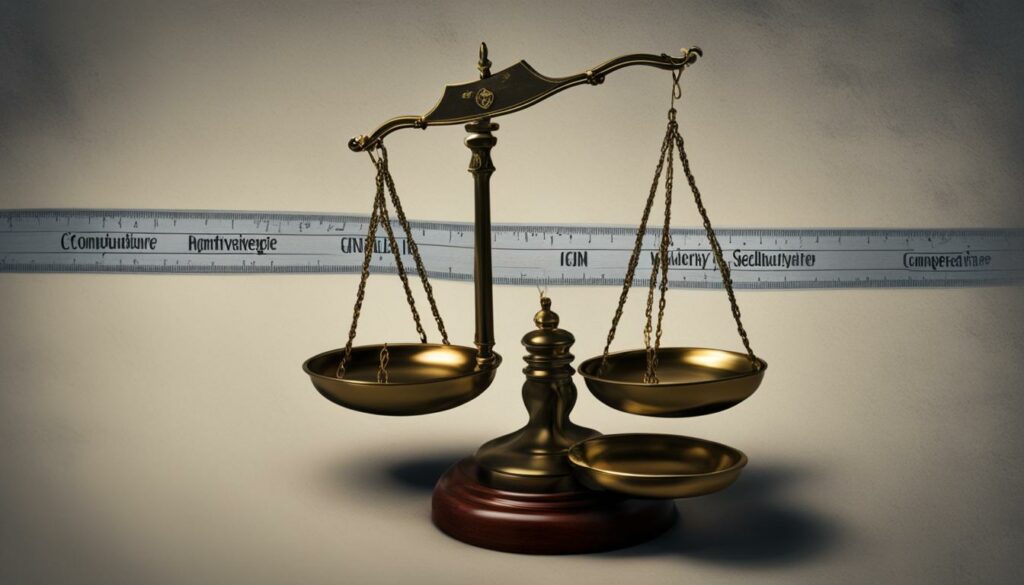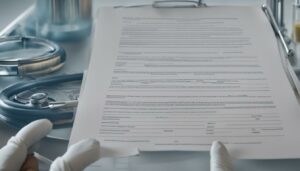In most personal injury cases, the concept of negligence plays a crucial role in determining fault. Negligence refers to the failure to meet the required level of reasonable care in a given situation. To establish negligence in a personal injury case, four key elements must be proven: duty of care, breach of duty, causation, and harm or damages.
Key Takeaways:
- Negligence is a critical factor in personal injury cases, determining fault.
- The four elements of negligence in personal injury cases are duty of care, breach of duty, causation, and harm or damages.
- Duty of care refers to the legal responsibility to avoid causing harm to others.
- Breach of duty occurs when the required level of care is not met.
- Causation establishes a direct link between the defendant’s breach of duty and the plaintiff’s injuries.
Elements of Negligence in Personal Injury Cases
To prove negligence in a personal injury case, the plaintiff must establish four essential elements. Firstly, they must show that the defendant owed them a duty of care. Secondly, they need to demonstrate that the defendant breached that duty by acting unreasonably. Thirdly, they must establish that the defendant’s breach of duty caused their injuries. Finally, they need to provide evidence of the harm or damages they have suffered as a result of the defendant’s negligence.
| Elements of Negligence in Personal Injury Cases |
|---|
| 1. Duty of care |
| 2. Breach of duty |
| 3. Causation |
| 4. Harm and damages |
Proving negligence requires a careful examination of each element. The first element, duty of care, establishes the legal responsibility of the defendant to act with reasonable care towards the plaintiff. This duty may vary depending on the specific circumstances of the case, such as the relationship between the parties or the nature of the defendant’s actions.
The second element, breach of duty, focuses on whether the defendant failed to meet the required standard of care. This can be shown through evidence of the defendant’s actions or inactions that deviated from what a reasonable person would do in the same situation. Eyewitness testimonies, expert opinions, and other forms of evidence can help establish a breach of duty.
Causation, the third element, requires the plaintiff to demonstrate that the defendant’s breach of duty directly caused their injuries. This involves establishing both cause-in-fact and proximate cause. Cause-in-fact means that the injury would not have occurred without the defendant’s breach, while proximate cause determines whether the harm was reasonably foreseeable based on the defendant’s actions.
The final element, harm and damages, involves proving the extent of the plaintiff’s injuries and the losses they have suffered. This can include medical expenses, lost wages, pain and suffering, and emotional distress. Documenting these damages and gathering supporting evidence is crucial to seeking compensation for the injuries caused by the defendant’s negligence.
Related Post: Personal Injury Cases – The Process
Duty of Care in Personal Injury Cases
In personal injury cases, establishing duty of care is a crucial element in proving negligence. Duty of care refers to the legal responsibility an individual has to avoid causing harm to others. It means that every person has an obligation to act reasonably and prudently in situations where their actions could potentially harm someone else. In personal injury cases, duty of care involves showing that the defendant had a duty to act with reasonable care towards the plaintiff in the specific situation that led to the injury.
Duty of care can vary depending on the circumstances and the relationship between the parties involved. For example, drivers have a duty of care to operate their vehicles safely and follow traffic laws to avoid accidents. Property or business owners have a duty of care to maintain their premises in a safe condition to prevent injuries to visitors. Medical professionals have a duty of care to provide a certain standard of care to their patients. Manufacturers have a duty of care to produce safe and reliable products.
The duty of care in personal injury cases is not absolute and may be influenced by factors such as the foreseeability of harm, the relationship between the parties, and the standard of care expected in a particular situation. Establishing duty of care is essential because it sets the foundation for determining whether the defendant’s actions fell below the required standard and led to the plaintiff’s injuries.
Examples of Duty of Care in Personal Injury Cases
In personal injury cases, duty of care can manifest in various scenarios. Here are a few examples:
- A driver has a duty of care to operate their vehicle responsibly and follow traffic laws to protect other drivers, pedestrians, and cyclists.
- A business owner has a duty of care to maintain a safe environment for customers, ensuring that their premises are free from hazards that could cause injuries.
- A doctor has a duty of care to provide competent medical treatment, following established protocols and standards of care.
- A manufacturer has a duty of care to design and produce products that are safe for consumers and adequately warn of any potential risks.
These examples illustrate how duty of care plays a fundamental role in personal injury cases by establishing the legal framework for determining negligence and liability. By proving that the defendant breached their duty of care, the plaintiff can seek compensation for the harm and damages they have suffered as a result of the defendant’s negligence.
Breach of Duty in Personal Injury Cases
In personal injury cases, establishing a breach of duty is a crucial element in proving negligence. Breach of duty refers to the defendant’s failure to meet the required level of care and act reasonably in a given situation. To successfully demonstrate breach of duty, the plaintiff must provide evidence that shows how the defendant’s actions or lack thereof fell short of meeting the expected standard of care.
There are various types of evidence that can be presented to establish a breach of duty. This includes eyewitness testimonies, violation of laws or regulations, expert opinions, and examination of the accident scene. By carefully analyzing these pieces of evidence, it becomes possible to demonstrate how the defendant’s behavior was responsible for causing the plaintiff’s injuries.
Examples of Breach of Duty
“The defendant, a healthcare professional, failed to diagnose the plaintiff’s condition, leading to delayed treatment and further harm.”
“The defendant, a property owner, neglected to repair a hazardous condition on their premises, resulting in a slip and fall accident.”
“The defendant, a driver, acted negligently by running a red light, causing a collision and injuring the plaintiff.”
By establishing a breach of duty, the plaintiff can strengthen their case by demonstrating how the defendant’s actions deviated from what a reasonably prudent person would have done in similar circumstances. This element is essential for proving negligence and holding the responsible party accountable for their actions.
| Type of Negligence | Description |
|---|---|
| Gross Negligence | A reckless disregard for the consequences of one’s actions, going beyond ordinary negligence. |
| Contributory Negligence | The plaintiff’s own negligent actions that contributed to their injuries. In some jurisdictions, even a small percentage of fault can bar the plaintiff from recovering compensation. |
| Comparative Negligence | Fault is allocated between the parties involved, and the compensation awarded is reduced based on each party’s percentage of fault. |
| Vicarious Negligence | An entity or individual is held responsible for the negligence of another, such as an employer being held liable for the actions of an employee. |
Causation in Personal Injury Cases
Causation is a crucial element in personal injury cases, as it establishes the direct link between the defendant’s breach of duty and the plaintiff’s injuries. To prove causation, two aspects must be considered: cause-in-fact and proximate cause.
Cause-in-Fact
Cause-in-fact, also known as “but for” causation, requires demonstrating that the plaintiff’s injuries would not have occurred “but for” the defendant’s breach of duty. In other words, if the defendant had acted with reasonable care, the injury would not have happened. This aspect of causation requires showing a direct causal connection between the defendant’s actions and the plaintiff’s harm.
Proximate Cause
Proximate cause focuses on whether the harm caused by the defendant’s breach of duty was a foreseeable consequence of their actions. It considers whether the defendant could have reasonably anticipated the type of harm that resulted from their negligent conduct. Proximate cause helps determine the boundaries of legal responsibility and ensures that defendants are held accountable for the reasonably foreseeable consequences of their negligence.
In a personal injury case, establishing both cause-in-fact and proximate cause is essential to prove causation. This requires presenting evidence, such as medical reports, expert testimonies, and expert analysis of the accident or incident. By establishing causation, the plaintiff can demonstrate how the defendant’s negligent actions directly resulted in their injuries, strengthening their case for compensation.
Harm and Damages in Personal Injury Cases
In personal injury cases, the harm and damages suffered by the plaintiff play a crucial role in determining the compensation they are entitled to. These harms and damages can encompass a wide range of physical, emotional, and financial losses that result from the defendant’s negligence.
Physical injuries are one of the most common types of harm in personal injury cases. These injuries can range from minor cuts and bruises to severe fractures, traumatic brain injuries, or spinal cord damage. Medical expenses incurred as a result of these injuries, including hospital bills, surgeries, medications, and rehabilitation, are also considered damages that the plaintiff can seek compensation for.
Furthermore, personal injury cases often involve the loss of income or earning capacity due to the inability to work. Lost wages and future earning potential can be significant damages in these cases, and the plaintiff can seek compensation for both past and future financial losses.
| Harm and Damages in Personal Injury Cases |
|---|
| Physical injuries |
| Medical expenses |
| Lost wages and earning capacity |
| Pain and suffering |
| Emotional distress |
| Disfigurement |
| Loss of companionship |
Pain and suffering, which refers to the physical and emotional distress experienced by the plaintiff, is another significant component of damages. This can include the pain, discomfort, and mental anguish caused by the injury and its aftermath. Emotional distress, such as anxiety, depression, or post-traumatic stress disorder, resulting from the accident can also be considered in the assessment of damages.
Other possible damages in personal injury cases include disfigurement, which may result from scarring or permanent injuries, and loss of companionship, which refers to the impact on personal relationships and the emotional support provided by the plaintiff.
It is important for the plaintiff to provide thorough documentation, including medical records, bills, and expert testimonies, to support their claim for damages. By presenting a comprehensive case, the plaintiff can increase their chances of receiving fair compensation for the harm and damages they have suffered.
Types of Negligence in Personal Injury Cases
In personal injury cases, negligence can take on different forms, depending on the circumstances of the incident. Understanding the various types of negligence is crucial in determining liability and seeking compensation for the injuries sustained. The following are some common types of negligence that can arise in personal injury cases:
Gross Negligence:
Gross negligence involves a reckless disregard for the consequences of one’s actions. It goes beyond ordinary negligence and is characterized by extreme carelessness or intentional misconduct. An example of gross negligence would be a medical professional performing a procedure under the influence of drugs or alcohol, resulting in severe harm to the patient.
Contributory Negligence:
Contributory negligence occurs when the plaintiff’s own actions contribute to their injuries. In some jurisdictions, if the plaintiff is found to have contributed even slightly to the accident, they may be denied compensation. For example, if a pedestrian was crossing the street outside of a designated crosswalk when they were hit by a speeding car, their contributory negligence may be considered.
Comparative Negligence:
Comparative negligence is a legal principle that allocates fault between the parties involved based on their degree of negligence. In states that have adopted comparative negligence, the compensation awarded to the plaintiff is reduced in proportion to their percentage of fault. For instance, if a cyclist is found to be 20% at fault for a collision with a car, their compensation may be reduced by 20%.
Vicarious Negligence:
Vicarious negligence holds an entity or individual responsible for the negligence of another person. This often applies to employers who can be held vicariously liable for the actions of their employees while on the job. For example, if a delivery driver causes an accident while making deliveries for a company, the company may be held vicariously liable for the damages caused.
Understanding these different types of negligence is essential when navigating personal injury cases. Depending on the circumstances, different types of negligence may apply, and establishing liability will require careful examination of the facts and evidence surrounding the incident. By consulting with experienced legal professionals, plaintiffs can effectively pursue their claims and seek appropriate compensation for their injuries.
Gross Negligence in Personal Injury Cases
Gross negligence is the most severe form of negligence, characterized by a reckless disregard for the harmful consequences of one’s actions. It goes beyond ordinary negligence and involves behaviors that go far beyond what a reasonable person would do. In personal injury cases, a finding of gross negligence can have significant implications, potentially resulting in higher damages awarded to the injured party.
A clear example of gross negligence in a personal injury case would be a driver excessively speeding in a school zone and causing a serious accident. This deliberate and reckless violation of traffic laws demonstrates a complete disregard for the safety of others, making it a prime example of gross negligence.
When it comes to proving gross negligence in a personal injury case, it is crucial to gather evidence that demonstrates the defendant’s extreme level of disregard for the well-being of others. This may include eyewitness testimonies, video footage, expert analysis, or any other relevant documentation. By establishing gross negligence, the injured party can strengthen their case and potentially receive higher compensation for their injuries and resulting damages.
| Gross Negligence | Ordinary Negligence |
|---|---|
| Reckless disregard for the consequences of one’s actions | Failure to exercise the level of care that a reasonable person would in similar circumstances |
| Behaviors that go beyond what a reasonable person would do | Failure to meet the required level of reasonable care |
Gross negligence is a critical concept in personal injury law, as it highlights the severity of the defendant’s actions and their level of culpability. By proving gross negligence, the injured party can seek the compensation they deserve for the physical, emotional, and financial hardships they have endured as a result of the defendant’s extreme negligence.
Contributory and Comparative Negligence in Personal Injury Cases
When it comes to personal injury cases, contributory negligence and comparative negligence are two important concepts that can significantly impact the outcome of a lawsuit. Let’s explore what these terms mean and how they are applied in the legal context.
Contributory negligence refers to the plaintiff’s own negligent actions that contributed to their injuries. In personal injury cases where contributory negligence is recognized as a defense, even if the plaintiff is found to be only 1% responsible for the accident, they may be denied compensation. This means that if the plaintiff’s actions in any way contributed to the accident or their injuries, they may be barred from recovering damages.
On the other hand, comparative negligence is a legal principle that allocates fault between the parties involved in an accident. Under comparative negligence, the compensation awarded to the plaintiff is reduced based on the percentage of fault assigned to each party. For example, if the plaintiff is determined to be 20% at fault for an accident, their compensation will be reduced by that percentage.
Contributory Negligence vs. Comparative Negligence
There are significant differences between contributory negligence and comparative negligence. Contributory negligence is an all-or-nothing rule, meaning that if the plaintiff is found to be even slightly at fault, they cannot recover any damages. Comparative negligence, on the other hand, allows for the apportionment of fault, ensuring that each party is held accountable based on their degree of responsibility.
Most states have adopted comparative negligence systems, either in a pure or modified form. In pure comparative negligence states, the plaintiff can recover compensation even if they are primarily responsible for the accident, although the amount awarded will be reduced according to their degree of fault. In modified comparative negligence states, the plaintiff can only recover compensation if their degree of fault falls below a certain threshold, typically 50% or 51%.
It is worth noting that the principles of contributory negligence and comparative negligence can vary from state to state. Therefore, it is crucial to consult with a knowledgeable personal injury attorney who can provide guidance based on the specific laws and regulations applicable to your case.
Table: A Comparison of Contributory Negligence and Comparative Negligence
| Aspect | Contributory Negligence | Comparative Negligence |
|---|---|---|
| Fault Allocation | All-or-nothing: Plaintiff cannot recover if found even slightly at fault | Fault is apportioned between parties based on their degree of responsibility |
| Compensation | Plaintiff is denied compensation if found at fault | Plaintiff can recover compensation, but the amount is reduced based on their degree of fault |
| States Adopting | Not widely adopted, only a few states follow contributory negligence | Most states have adopted comparative negligence, either in a pure or modified form |
Understanding the concepts of contributory negligence and comparative negligence is essential in personal injury cases. They have significant implications for the outcome of a lawsuit and the compensation that the injured party may be entitled to. If you find yourself involved in a personal injury case, consult with a qualified attorney who can provide expert advice and guide you through the legal process.

Vicarious Negligence in Personal Injury Cases
Vicarious negligence is a legal concept that holds an entity or individual responsible for the negligence of another. This often comes into play in personal injury cases, particularly in employment contexts. For example, if an employee causes an accident while driving a company vehicle, the employer may be held vicariously liable for the damages caused. It is important to understand the implications of vicarious negligence and how it can impact personal injury claims.
When it comes to vicarious negligence, the key factor is the relationship between the negligent party and the entity or individual being held responsible. This relationship is typically one of employment or agency, where the negligent party is acting within the scope of their employment or authority. The idea behind vicarious liability is that the entity or individual who benefits from the actions of the negligent party should also bear the responsibility for any harm caused.
In personal injury cases, vicarious liability can have significant implications for seeking compensation. It allows victims to hold not only the directly negligent party accountable but also the entity or individual with a legal relationship to them. This can increase the chances of recovering fair compensation for the injuries and damages suffered, ensuring that all responsible parties are held liable for their negligence.
| Benefits of Vicarious Liability in Personal Injury Cases |
|---|
| Vicarious liability allows victims to pursue compensation from entities or individuals with more substantial financial resources. |
| It holds employers accountable for the actions of their employees, promoting better safety standards and responsible hiring practices. |
| Vicarious liability ensures that all parties involved in the negligent act are held responsible, providing a more comprehensive avenue for seeking justice. |
Overall, vicarious negligence plays a crucial role in personal injury cases. It expands the scope of liability beyond just the directly negligent party, allowing victims to seek compensation from entities or individuals with a legal relationship to the negligent party. By understanding the concept of vicarious liability, personal injury victims can navigate the legal process more effectively and increase their chances of obtaining the compensation they deserve.
Seeking Compensation in Personal Injury Cases
When it comes to personal injury cases, seeking compensation for the damages suffered is a paramount objective. Whether you have incurred medical expenses, lost wages, or endured pain and suffering, it is crucial to pursue the compensation you deserve.
In order to effectively seek compensation, it is important to gather and present evidence of your damages. This can include medical records, bills, and statements, as well as documentation of lost income and any other financial losses you have experienced as a result of the injury. Additionally, providing witness testimonies or expert opinions can strengthen your case and help establish the extent of your damages.
Having legal representation can significantly enhance your chances of obtaining fair compensation. An experienced personal injury attorney can guide you through the legal process, advocate for your rights, and negotiate with insurance companies or opposing parties on your behalf. They will work diligently to build a strong case and ensure that you are fully compensated for the injuries and losses you have suffered.
Remember, seeking compensation in personal injury cases is not a simple task, but with the right legal support and thorough documentation of your damages, you can increase your chances of obtaining the compensation you deserve.
FAQ
What is negligence in personal injury cases?
Negligence refers to the failure to meet the required level of reasonable care in a given situation. In personal injury cases, it plays a crucial role in determining fault.
What are the elements of negligence in a personal injury case?
The four key elements of negligence in a personal injury case are duty of care, breach of duty, causation, and harm or damages.
What is duty of care in a personal injury case?
Duty of care refers to the legal responsibility an individual has to avoid causing harm to others. It involves showing that the defendant had a duty to act with reasonable care towards the plaintiff in the specific situation that led to the injury.
How is breach of duty established in a personal injury case?
Breach of duty can be shown through evidence of the defendant’s actions or lack thereof, including violation of laws, eyewitness testimonies, and examination of the accident scene. It involves proving that the defendant acted unreasonably or failed to meet the required level of care.
What is causation in a personal injury case?
Causation involves proving that the defendant’s breach of duty of care directly caused the plaintiff’s injuries. It includes establishing cause-in-fact, which shows that the injury would not have occurred “but for” the defendant’s breach, and proximate cause, which determines whether the defendant could have reasonably foreseen the type of harm that resulted from their actions.
What constitutes harm and damages in a personal injury case?
Harm and damages in a personal injury case can include physical injuries, medical expenses, lost wages, pain and suffering, emotional distress, disfigurement, and loss of companionship. The plaintiff must provide evidence of these damages to recover compensation for their injuries.
What are the different types of negligence in personal injury cases?
The different types of negligence in personal injury cases include gross negligence, contributory negligence, comparative negligence, and vicarious negligence.
What is gross negligence in a personal injury case?
Gross negligence is the most severe form of negligence, characterized by a reckless disregard for the harmful consequences of one’s actions. It involves behaviors that go far beyond what a reasonable person would do and can result in higher damages.
What is the difference between contributory negligence and comparative negligence?
Contributory negligence refers to the plaintiff’s own negligent actions that contributed to their injuries. In jurisdictions that allow it as a defense, even a small percentage of fault on the plaintiff’s part can deny them compensation. Comparative negligence, on the other hand, allocates fault between the parties involved and reduces compensation based on each party’s percentage of fault.
What is vicarious negligence in a personal injury case?
Vicarious negligence occurs when an entity or individual is held responsible for the negligence of another. It often applies in employment contexts, where an employer can be held vicariously liable for the negligence of an employee while on the job.
How can I seek compensation in a personal injury case?
To seek compensation in a personal injury case, you need to provide evidence of your damages, including medical expenses, lost wages, pain and suffering, and more. Proper documentation, expert testimonies, and legal representation can help you recover the compensation you deserve.










